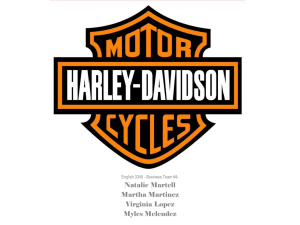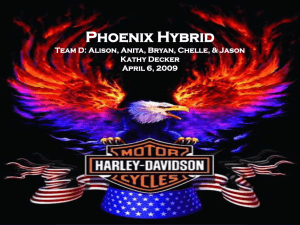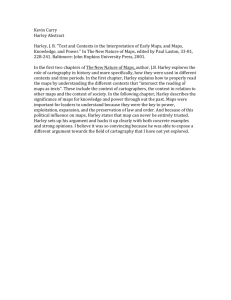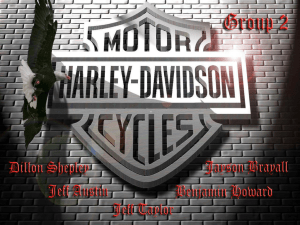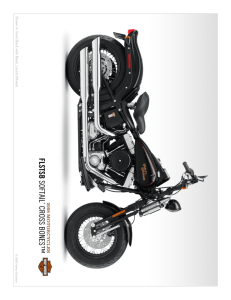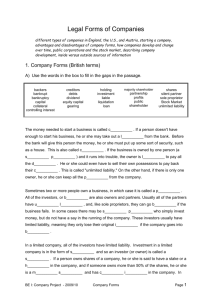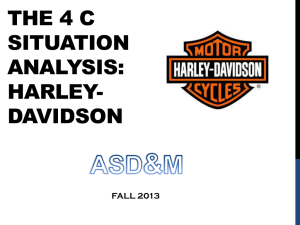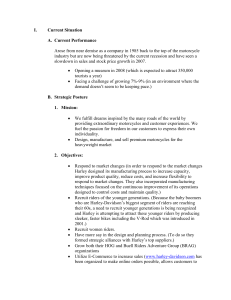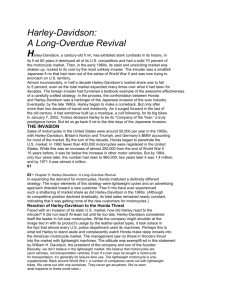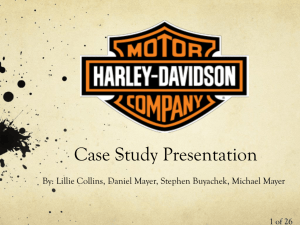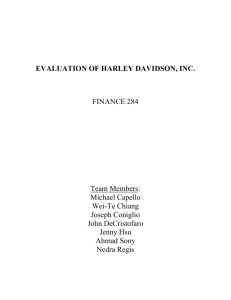Harley Davidson Presentation - Harley Davidson as a cultural product
advertisement
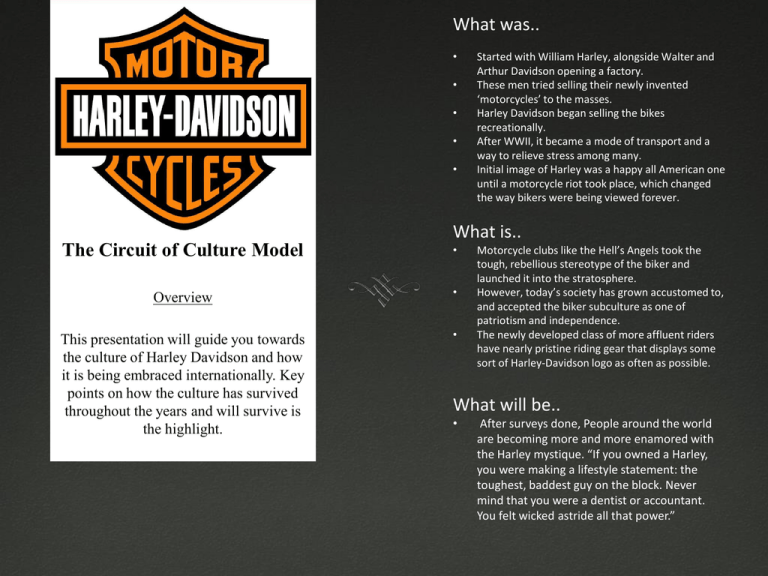
What was.. • • • • • The Circuit of Culture Model Started with William Harley, alongside Walter and Arthur Davidson opening a factory. These men tried selling their newly invented ‘motorcycles’ to the masses. Harley Davidson began selling the bikes recreationally. After WWII, it became a mode of transport and a way to relieve stress among many. Initial image of Harley was a happy all American one until a motorcycle riot took place, which changed the way bikers were being viewed forever. What is.. • Overview • This presentation will guide you towards the culture of Harley Davidson and how it is being embraced internationally. Key points on how the culture has survived throughout the years and will survive is the highlight. • Motorcycle clubs like the Hell’s Angels took the tough, rebellious stereotype of the biker and launched it into the stratosphere. However, today’s society has grown accustomed to, and accepted the biker subculture as one of patriotism and independence. The newly developed class of more affluent riders have nearly pristine riding gear that displays some sort of Harley-Davidson logo as often as possible. What will be.. • After surveys done, People around the world are becoming more and more enamored with the Harley mystique. “If you owned a Harley, you were making a lifestyle statement: the toughest, baddest guy on the block. Never mind that you were a dentist or accountant. You felt wicked astride all that power.” Representation & Identity Harley Davidson is a strong brand. Why? Because of the emotion & imagery it evokes : Outlaw Motorcycle gangs Leather Jackets Tattoos Fierceness Dark straddling rider Loud rambling engines “The bikers of today though, are the ones responsible for maintaining an image and lifestyle that is worthy to reflect the spirit of those who came before them in order to pass the torch on to the bikers of the future.” – Gary Johnstone According to Financial World magazine, a cover story on the new face of bikers describes the “new breed of well-heeled, middle-aged Harley enthusiasts whom journalists like to identify as rich urban bikers, to differentiate them from Harley's traditional road-hardened blue-collar core customers. Similarly.. Johnstone also stated that “Motorcycle owners have changed. They're older, more affluent, better educated -- and a lot more women ride their own.” Because of the ideas and behavior of early enthusiasts, the legend of the Harley-Davidson motorcycle, and the lifestyle it represents has defined the existence of thousands, and helped many more to experience a re-birth of the human soul. These issues can obviously cause resentment inside of the historically blue-collar subculture. “Harley-Davidson logos and trademarks symbolize more than just the quality and heritage of our products. They stand for something important enough that people tattoo them on their skin. It’s something that can’t easily be expressed with words, but is felt in the soul. For many, “Harley-Davidson” isn’t a name or a brand. It’s a way of life.” Picture credits : Google.com/images of Harley Davidson Production & Consumption Production Sales of new bikes were up by 30% nationwide (USA) Better & cheaper models re-released for affordability which widens the consumption market. Cash cycle shorter as Dealers are selling new bikes below recommended prices Consumption International successful sale figures because of : Bike lover’s awareness Loyal Riders & Collectors Successful marketing/branding strategy Ideology of ‘anyone that owns a Harley is cool regardless their job’ promoted Histories of Harley consumption Harley-Davidson continues to maintain an intimate relationship with riders through activities like corporate sponsorship of and participation. “Observed among Harley owners is their tendency to develop both technological and stylistic advancements in motorcycle equipment and clothing. Such "grass-roots r & d" is not unique to the biker subculture, but is in fact visible in many subcultures or groups that exhibit extraordinary commitment to a particular class of products or consumption activities” – Wagner (2003) Regulation & Methodology Regulation Research Methodology However, there are two groups of riders: Fulltime riders & Weekend Rider. • • • The bikes themselves tend to say a lot about the rider. Weekend riders usually ride newer HarleyDavidson models such as: Fatboys, Roadkings, Nighttrains, and V-Rods. Fulltime bikers, however, like to ride older models like: Badboys, Knuckleheads, Panheads, and Lowriders. The bike a person chooses can really say something about his or her taste in motorcycles; however, the most important decision involved with a person’s bike is the way they choose to customize it, so that it stands out from the crowd. (consumption leading to regulation) Both groups mingle well and most topics of conversation are centered around the bikes, of course. Although the two sides look alike, the differences are all to clear. Read ethnographies of Harley Davidson Surveys (Quantitative research) Interviews (Qualitative Research) Challenges & Further Question Ensuring that the bikers of today are responsible enough for maintaining an image and lifestyle that is worthy to reflect the spirit of those who came before them in order to pass the torch on to the bikers of the future is the challenge that Harley Davidson faces. (Hugo,1993) With the biker congregation growing rapidly internationally? How is the identity of the bikers going to be sustained or how much would the identity change over time? References to be sourced: Hopper, Columbus B. and Johnny Moore (1983), "Hell on Wheels: The Outlaw Motorcycle Gangs," Journal of American Culture, 6 (Summer), 58-64. Johnstone, Gary (1995) "Union Pacific Meets Roy Rogers". Classic Motorcycles. Twickenham: Tiger Books International. p. 5 Wagner, Herbert (2003). At the Creation: Myth, Reality, and the Origin of the Harley-Davidson Motorcycle, pp.22–28, 42–44. Wilson, Hugo (1993). "The World's Motorcycles: America" (in UK English). The Ultimate Motorcycle Book. London: Dorling Kindersley. p. 17. http://auto.howstuffworks.com/harley.htm http://www.harleydavidson.com/wcm/Content/Pages/Career_Opportunities/mission_and_values.jsp?locale=en_US
